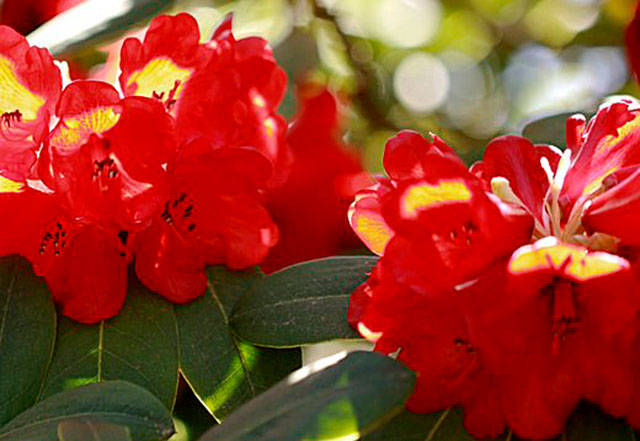Rhododendrons are beautiful plants, prolific and well suited for growing in the Pacific Northwest. But, how much do you really know about these mythically indestructible plants?
True or False: All azaleas are rhododendrons.
True. The genus Rhododendron is a large group and includes all azaleas. However, keep in mind, all rhododendrons are not azaleas! That said, the discussion of rhododendrons includes azaleas unless otherwise noted.
T/F: Rhododendrons are native to the Pacific Northwest.
Well, true, there are a few rhododendrons native to the Pacific Northwest. Washington State’s official flower is the beautiful Pacific Rhododendron, R. macrophyllum. But there over 900 species of rhododendron and countless more thousands of hybrids that are not native to this area. The plants you encounter at a local nursery will more than likely not be of a native variety. The Pacific Northwest is fortunate to have a climate prime for growing a wide range of rhododendrons.
T/F: Rhododendrons are easy to grow.
True, if you do your homework and plant them properly. Rhododendrons need a few specific conditions: humus-rich acidic soil, consistent moisture and excellent drainage. It’s better to plant a Rhododendron a little high and provide good quality mulch than to risk root rot. More rhododendrons die quickly from drowning than drought.
T/F: All rhododendrons need shade. False.
With the tens of thousands of species, sub species, hybrids and varieties available, the myth that they all require the same light conditions is fanciful. There are beautiful plants of all shapes, sizes and colors for a myriad of locations.
T/F: Rhododendrons are essentially pest-free.
False. Just like any other plant, a healthy rhododendron will repel pests and disease. Choosing a rhododendron suited to your site is the first defense. Because stressed plants are more susceptible to problems, good cultural practices is the next step. In the Pacific Northwest a major stress can be inadequate or inconsistent summer water. Rhododendron and Azalea lace bug is a difficult pest best thwarted by robust health. One of the hardest pests to manage is root weevil. Root weevil is enough of a problem that there are lists of weevil-resistant rhododendrons. An extensive list can be found in a free download at www.pubs.wsu.edu; search EB0970E.
T/F: Rhododendrons do not need to be pruned.
True, only if you want wild overgrown plants. Probably the first and most often asked question at any rhododendron talk is: “I have a huge rhododendron that is consuming my house, what to do?” Rhododendrons may need less attention but they do benefit from some pruning. Every year after bloom you should evaluate your plants and follow the four “Ds.”
First deadhead: That is, remove the faded flowers. This keeps the plant from extending too much energy forming seeds and it looks more attractive. Next are damaged or diseased branches: Cut them out any time of year. The last “D” is to direct the plants growth. If your plant has decided to grow over a path or in front of a window, selectively remove branches to direct its growth where you want it. And realize that plant tags that say “grows to 8 feet” means that it grows to 8 feet in 10 years. After that time you will be the person asking the questions about an unruly rhododendron.
T/F: The American Rhododendron Society has an awesome website for people who want to learn more about this outstanding ornamental plant.
True! See www.rhododendron.org.
Susan Kalmer is a Clallam County Master Gardener.


